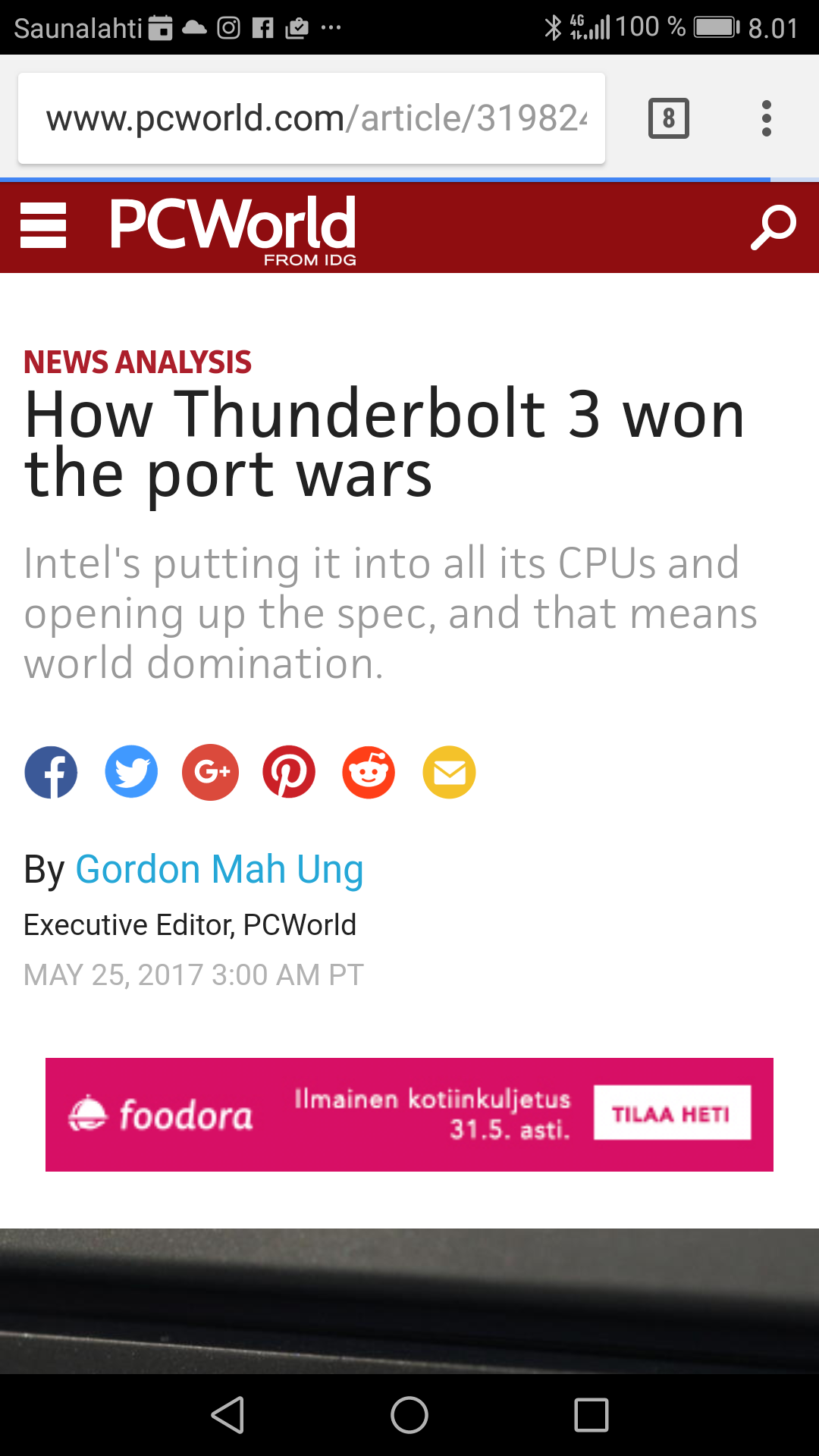http://www.pcworld.com/article/3198249/computers/how-thunderbolt-3-won-the-port-wars.html
On Wednesday, Intel announced it will integrate Thunderbolt 3 into future CPUs. More importantly, the company said it would open up the long-secret protocol to the world, royalty-free.
A world where one USB-C connector does it all—today, and for many years to come.
https://newsroom.intel.com/editorials/envision-world-thunderbolt-3-everywhere/

3 Comments
Tomi Engdahl says:
Envision a World with Thunderbolt 3 Everywhere
https://newsroom.intel.com/editorials/envision-world-thunderbolt-3-everywhere/
Intel Announces Plans to Integrate Thunderbolt 3 into Future Intel CPUs and to Release the Thunderbolt Protocol Specification to the Industry
Intel’s vision for Thunderbolt was not just to make a faster computer port, but a simpler and more versatile port available to everyone. We envision a future where high-performance single-cable docks, stunning photos and 4K video, lifelike VR, and faster-than-ever storage are commonplace. A world where one USB-C connector does it all – today, and for many years to come. With this vision in mind, Intel is announcing that it plans to drive large-scale mainstream adoption of Thunderbolt by integrating Thunderbolt 3 into future Intel CPUs and by releasing the Thunderbolt protocol specification to the industry next year.
With Thunderbolt 3 integrated into the CPU, computer makers can build thinner and lighter systems with only Thunderbolt 3 ports. For the first time, all the ports on a computer can be the same – any port can charge the system and connect to Thunderbolt devices, every display and billions of USB devices. Designs based on Intel’s integrated Thunderbolt 3 solution require less board space and reduce power by removing the discrete component needed for existing systems with Thunderbolt 3.
“Apple and Intel have collaborated on Thunderbolt from the beginning, and as the industry leader in its adoption, we applaud Intel’s efforts to integrate Thunderbolt technology into its CPUs and open it up to the rest of the industry,” said Dan Riccio, Apple’s senior vice president of Hardware Engineering.
Microsoft has enhanced Thunderbolt 3 device plug-and-play support in the now available Windows 10 Creators Update. Intel and Microsoft plan to continue to work together to enhance the experience in future versions of the Windows operating system.
Tomi Engdahl says:
Intel to Strike Thunderbolt in CPUs
http://www.eetimes.com/author.asp?section_id=36&doc_id=1331825&
Thunderbolt is finally on the path to mass adoption thanks to Intel’s move to integrate it in future processors and make licensing it easier.
With speeds of 40 Gbits/second, plug-and-play support and a single unified cable design, Thunderbolt should be the most adopted and accepted cabling interface in the market today. But sullied by a quagmire of complications around ports, licenses, hardware integration and more, its uptake has been somewhat stagnant.
When Thunderbolt was first released, the motherboards, systems and notebooks that integrated it had a significant price premium. With Thunderbolt 2 and now 3, costs have come down some, but accessories like expansion docks and external storage are still significantly more expensive than USB 3.0 or USB 3.1 counterparts.
Unfortunately there’s a large amount of confusion in the market around the Type-C connector USB 3.1 and Thunderbolt 3 share. Type-C is a form factor of cable and port that can be used for USB 3.1 Gen1 (essentially running at USB 3.0 speeds), Gen2 (at up to 10 Gbits/s) and Thunderbolt 3 (up to 40 Gbits/s with other features).
Many systems for sale today have USB Type-C ports that may support USB or Thunderbolt or both. To know the difference, the consumer is asked to read a tiny icon that differs from vendor to vendor on the side of their machine. In some instances, a machine might have multiple kinds of Type-C ports on it.
Another drawback for Thunderbolt 3 is that support for true plug-and-play compatibility varies depending on the chipset on either side of the connection. TB3 promised USB-like connectivity without rebooting systems, but in some cases that process only works one-way (plugging in or unplugging) or it might be slightly unstable.
Tomi Engdahl says:
Intel to Strike Thunderbolt in CPUs
http://www.eetimes.com/author.asp?section_id=36&doc_id=1331825&
Intel thinks it has solution. The company will begin to integrate Thunderbolt 3 directly onto the CPU although it hasn’t specified when. Because the underlying architecture of Thunderbolt is PCI Express, Intel could either add additional PCIe lanes to future architectures or it could redistribute the existing ones into the necessary Thunderbolt processing logic on-package or on-die.
This move will lower both cost and power draw. OEMs will not need a separate, external Thunderbolt controller and tracing on a motherboard, enabling thinner, lighter systems with longer battery life.
Intel is also changing the licensing policy for Thunderbolt, moving to a non-exclusive, royalty-free license. This removes another cost restriction, allowing third parties to build Thunderbolt-capable controllers for storage, displays, docks and more without worrying about associated fees. Without the need for an Alpine Ridge chip from Intel, more accessories at lower prices will grow the market.